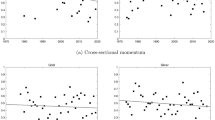Abstract
This paper examines the predictability of monthly aftermarket returns of initial public offerings during the first six years of trading. Predictability is tested under the null hypothesis of random walk using a Markov chain analysis. The evidence shows that excess returns of IPOs (adjusted for the return on the equally weighted NASDAQ index) demonstrate non-random walk behavior through the first five years of trading and random walk behavior in the sixth year. This is accompanied by predictability of monthly excess returns conditioned on the two previous months' excess returns. A trading strategy is offered to capitalize on the predictability patterns. Implementing the trading strategy is not possible due to institutional barriers, providing additional explanation for why IPOs do not reach their intrinsic values for extended periods of time.
Similar content being viewed by others
References
Aggarwal, Reena, Ricardo Leal, and Leonardo Hernandez, “The Aftermarket Performance of Initial Public Offerings in Latin America.” Financial Management 22(1), 42–53, 1993.
Aggarwal, Reena, and Pietra Rivoli, “Fads in the Initial Public Offering Market.” Financial Management 19(4), 45–57, 1990.
Bessembinder, Hendrik, and Michael Hertzel, “Return Autocorrelation around Nontrading Days.” Review of Financial Studies 6(1), 155–189, 1993.
Byrd, John, Douglas Hensler, and Scott Lee, “The Long-Run Performance of IPOs, Underwriter Reputation, and the Timing of IPO Offerings.” Working Paper University of Texas at Arlington, 1993.
Fama, Eugene, “Efficient Capital Markets: A Review of theory and Empirical Work.” Journal of Finance 25, 383–416, 1970.
Fama, Eugene, “Efficient Capital Markets: II.” Journal of Finance 46, 1575–1617, 1991.
Fama, Eugene, and Kenneth French, “Permanent and Temporary Components of Stock Prices.” Journal of Political Economy 96, 246–273, 1988.
Kim, M., Charles Nelson, and Richard Startz, “Mean Reversion in Stock Prices? A Reappraisal of the Empirical Evidence.” Review of Economic Studies 58,No. 3, 515–528.
Levis, Mario, “The Long-Run Performance of Initial Public Offerings: The UK Experience.” Financial Management 22(1), 28–41, 1993.
Lo, Andrew, and Craig MacKinley, “Stock market Prices Do Not Follow Random Walks: Evidence from a Simple Specification Test.” The Review of Financial Studies 1(1), 41–66, 1988.
Loughran, Tim, “NYSE vs. NASDAQ Returns, Market Microstructure or the Poor Performance of Initial Public Offerings?” Journal of Financial Economics 33,No. 2, 241–260, 1993.
Loughran, Tim and Jay Ritter, “The New Issues Puzzle.” Journal of Finance 50(1), 23–51, 1995.
McQueen, Grant, “Long-Horizon Mean-Reverting Stock Prices Revisited.” Journal of Financial and Quantitative Analysis 27(1), 1–18, 1992.
McQueen, Grant and Steven Thorley, “Are Stock Returns Predictable? A Test Using Markov Chains.” Journal of Finance 46(1), 239–263, 1991.
Patel, Jayendu, Richard Zeckhauser, and Darryll Hendricks, “The Rationality Struggle: Illustrations from Financial Markets.” American Economic Review 81, 232–236, 1991.
Poterba, James and Lawrence Summers, “Mean Reversion in Stock Prices: Evidence and Implications.” Journal of Financial Economics 22(1), 27–59, 1988.
Ritter, Jay R., “The “Hot Issue” Market of 1980.” Journal of Business 57, 215–240, (April 1984).
Ritter, Jay R., “The Long-Run Performance of Initial Public Offerings.” Journal of Finance 46(1), 3–48, 1991.
West, Kenneth, “Bubbles, Fads, and Stock Price Volatility Tests: A Partial Evaluation.” Journal of Finance 43(3), 639–656, 1988.
Zeckhauser, Richard, Jayendu Patel, and Darryll Hendricks, “Nonrational Actors in Financial Markets Behavior.” Theory and Decision 31, 257–287, (September 1991).
Author information
Authors and Affiliations
Rights and permissions
About this article
Cite this article
Hensler, D. The Nature and Persistence of Initial Public Offering Aftermarket Returns Predictability. Review of Quantitative Finance and Accounting 10, 39–58 (1998). https://doi.org/10.1023/A:1008296013545
Issue Date:
DOI: https://doi.org/10.1023/A:1008296013545




